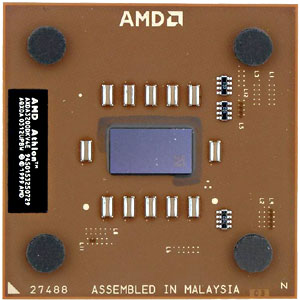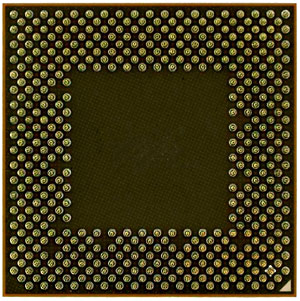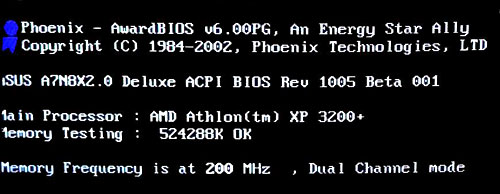 |
||
|
||
| ||
Taking into account that the launch of the Athlon XP 3000+ was given a cold reception, the new-comer 3200+ must have had it the same. Especially considering the paragraph below. But do not worry: the second attempt is not that bad, the Athlon XP 3200+ is much better than its predecessor, though there are few changes: the core frequency is jacked up to 2200 MHz (from 2167 MHz, i.e. only by 33MHz), and the bus got 33 MHz more - now it works at 400 MHz (200 MHz DDR). As a result, it looks like the Barton (3000+), only with the core and bus being speedier. However, this is the very quantity-to-quality transition. 
 Here it is...  Remember the marking! :) Chaos...There is something strange happening in AMD and its partners making chipsets with the new bus clock speeds supported. AMD says nothing about it, and the chipset makers add and remove new frequencies from the specs in a strange manner. First the nForce2 was the first chipset supporting both 333 MHz and 400 MHz FSB, and now 400 MHz is officially supported only by the new nForce 400/nForce 400 Ultra (the latter being actually a new revision of the nForce2's north bridge)...  The board incorporates the nForce2 Ultra 400, but... the marking is old  However, the board detects the processor correctly At the moment of announcement the VIA's Apollo KT400 chipset had the DDR400 support, then it lost it (JEDEC declined its standardization), then it got its support again (if everyone declared the support, why not we?), and now it doesn't have it (to make it different from the KT400A). If it doesn't support the FSB 400 MHz either, what for is the figure 400 in its name?! And what means "600" in the next chipset's name? I wouldn't like the 3D mess here with all those GeForce4 Ti 4800(SE) and Radeon 9100. Why SiS made the 746FX had been clear until it turned out that it wasn't compatible with the new FSB/DDR speeds. To cure it they released the 748 chipset that differed only in the 400 MHz FSB supported. It seems that either AMD doesn't know what it's going to develop next or it doesn't inform its partners about it. The partners, nevertheless, make new chipsets like hot pies attracting money of numerous enthusiasts. The chaos is really irritating... But, still, we've found a board in our test lab which supports all frequencies needed, and now let's have a look at the test results. PerformanceTestbed:
Software:
We couldn't get the top AMD processors for a long time, and we had to make a choice between testing the fastest Athlon XP in comparison with the fastest Pentium 4 (which might be of interest only for a narrow range of users), or focusing on comparison of the model 3200+ with its predecessors. The latter can help us estimate the effect from the faster FSB in comparison with the effect from the larger cache, which might be interesting for much more users. However, in June after the release of the Pentium 4 3.2 GHz we will try to compare these equal-rating processors. The Athlon XP 2700+, 3000+ and 3200+ have very close clock speeds (the difference of 33 MHz is intangible, it makes only 1.5%). So, we will compare exactly two technologies of processor acceleration and estimate how useful they are for the Socket A. The Pentium 4 3.06 GHz will be like an external reference point - not the fastest in the Intel's line, but still very expensive :). Test resultsGaming applicationsThe Athlon XP is gradually growing up: model 3000+ outscores the Pentium 4 3.06 GHz, and the 3200+ becomes a champion. If you look at the pairs of 2700+/3000+ and 3000+/3200+ you will see that the increased L2 cache doesn't help much while the higher bus speed makes a much more noticeable effect. However, we don't have the results of the Pentium 4 with 800 MHz FSB on the i865/875, that is why the final conclusion will be made after the release of the Pentium 4 3.2 GHz, the main rival of the Athlon XP 3200+. The picture is standard for both games: in the Return to Castle Wolfenstein preferable for Intel processors (Quake III engine!) the Pentium 4 is ahead, and in the pro-AMD Serious Sam the first position if after the Athlon XP. But it's not that important. The situation when the 3200+ wins against the 3000+ by a greater margin than the 3000+ from 2700+ takes place in one more test (RtCW), which seems to be a tendency. RenderingWhen this packet was optimized for the Pentium 4, the Athlon XP, a former leader, lost the first place. But it doesn't make efforts to grow up: the scores of the Athlon XP 2700+ hardly differ from those of the 3200+. But AMD focuses on the growth of the FSB frequency and cache size, while the most important factor in rendering is the clock speed. Anyway, the 3200+ moves ahead faster than the 3000+ in comparison with the 2700+! Business and multimedia applicationsAs usual, the SYSmark packet presents these types of applications. In this case the diagrams do not show the results of the Pentium 4 because Intel didn't reply to the AMD's pretensions to this test, and now it's questionable whether it's fair to compare processors of these two companies in this test. Still, if you are interested in the Pentium4's scores in the SYSmark, you can get them here. As to the Athlon XP, the growth is noticeable. Let's calculate the index growth of the Athlon XP 3200+ over the 2700+ and compare it with the scores in the SYSmark. 3200/2700~=1.19, i.e. 19%. Office Productivity: 216/183~=1.18 (the same 18%), and Internet Content Creation: 349/274~=1.27 (27%), which is much more. It's nice to see that in such general test as SYSmark 2002, the AMD's index system proved to be correct even on the new processors. By the way, this is the only test where the gap between the 2700+ and 3000+ is greater than between the 3000+ and 3200+. Professional OpenGLAs you know, AMD used to mention that various SSE2 and other SIMDs are a tricky thing. It takes to much time to optimize software for them. They already have the fastest x87 FPU, and everything is already optimized for it. The SPECviewperf can partially prove these arguments. The developers of SPEC are quite conservative judging by the programs used - and I assume that they won't stick to the code and its optimization for various new instructions. So, you can see (we have taken three out of six results) that the Athlon XP 3200+ wins the race from the Pentium 4 3.06 GHz. Well, the results are good, though I wish the difference between the Athlons XP were more pronounced. On the other hand, it indicates the cause of the victory: the advantage of the architecture regarding a certain type of tasks. I must say that both architectures have long lists of "favorite applications"... Media Content EncodingAlthough the Pentium 4 still keeps the leader, the Athlon XP 3200+ comes very close to it (especially in the video encoding). The difference between the Athlon XP 3200+ and 3000+ is again greater than between the 3000+ and 2700+. That is why the Athlon XP 3200+ seems to be more successful than the previous AMD's top processor. The memory access speed and... peculiarities of the algorithm. The performance of the Pentium 4 and Athlon XP systems depends on the speed of the bus or memory subsystem. The Athlon XP 3200+ is still much faster than the 3000+... Only in the WinAce all Athlons feel much better, while in the WinRAR it's vice versa. This is a classic case of the architectural preference in the software which was discussed above. Low-level testsI think there is nothing to comment on in case of the Athlon XP vs. Pentium 4+i850E... This is the story about why the Pentium 4 wins where it wins. The excellent FPU, perfect architecture, short pipelines. But the memory read and write speeds are awful. The Athlon XP 3200+ is a good processor until we need a wide FSB, though AMD was first to get it! The Pentium III had the 133MHz single-cycle bus when the Athlon had a DDR-like EV-6 with the throughput equivalent to 266 MHz! On the other hand, we can use the scores of the i845GE to estimate how much the Pentium 4 based systems need the fast memory. In fact, this 3GHz monster is very limited by the i845 line. Where the Athlon XP's magic wand, FPU, acts, everything is ok. Well, it has the most powerful FPU than anybody else among classic IA-32 processors! When the SSE are used, the Pentium 4 wins in most cases. And with the SSE2 the Intel's processor becomes the absolute leader. The scores of the different Athlon XP are very close. However, this proves the positioning of the CPU RightMark - it measures performance of the processor core, that is why within the same architecture it's the most sensitive to the frequency, which is almost the same here. Conclusion: a failure or not?In general, the Athlon XP 3200+ is a good processor, though the reputation is certainly a bit spoiled by AMD and the chipset makers. At the moment it is adequate to the 3GHz Pentium 4. AMD says it's not going to give up the Athlon XP line for the sake of a pig in a poke - Athlon 64. However, it's still unclear whether the line will be further extended, for example, with the Athlon XP 3400+, and when. Performance of the new 400MHz bus will suffice for the 3400+. But the most important thing now is not allows the chipset markers to let AMD down. The only chipset adequate for the upper Athlon XP processors is nForce2, and one chipset for the whole platform is not enough. If VIA brings its KT600 in time, and the SiS748 is a good solution, the Socket A market will become much more promising. Well, the final conclusion is that the Athlon XP doesn't benefit much
from the L2 cache increased up to 512 KB, while the bus speed growth is
a very effective means.
Write a comment below. No registration needed!
|
Platform · Video · Multimedia · Mobile · Other || About us & Privacy policy · Twitter · Facebook Copyright © Byrds Research & Publishing, Ltd., 1997–2011. All rights reserved. |